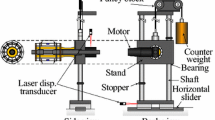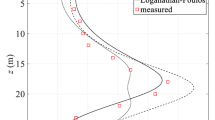Abstract
The tunneling process results in ground movement. The prediction of ground movement can be achieved by using numerical analysis, analytical methods, and empirical methods. In the present paper, a parametric study via finite element program (Plaxis2D) was implemented to investigate the effect of some parameters like volume loss, the relative density of sand, and cover-to-diameter ratio (C/D). For the verification and judging of the reliability of the model results, the finite element results were compared with field measurements of the Greater Cairo Metro tunnel. Moreover, the model results were validated using the empirical formula (Peck, Proceedings of the 7th International Conference on Soil Mechanics and Foundation Engineering, Mexico, pp 225–290, 1969). The results show that the numerical model results are fairly in agreement with the field measurements and empirical formula. The maximum value of the horizontal displacement occurred at the ground surface. Moreover, the horizontal displacement decreases, as the depth increases. The formula of peck gives an accurate value of the settlement and considers a reliable method for calculating the maximum settlement due to the tunneling process, especially in the preliminary stages of the project. The surface settlement calculated using volume loss = 0.5% is very close to real field observation. Furthermore, the width of the settlement trough increases, as the volume loss increases.
















Similar content being viewed by others
References
M.Y. Fattah, K.T. Shlash, N.M. Salim, Prediction of settlement trough induced by tunneling in cohesive ground. Acta Geotech. 8, 167–179 (2013). https://doi.org/10.1007/s11440-012-0169-4
D. Kolymbas, Tunnelling and tunnel mechanics: A rational approach to tunnelling. (Springer Science & Business Media, 2005)
R. Mair, R. Taylor, Theme lecture: Bored tunneling in the urban environment. In Proceedings of the Fourteenth International Conference on Soil Mechanics and Foundation Engineering (Hamburg, Balkema, 1997) pp. 2353–2385
R. Farrell, R. Mair, A. Sciotti, A. Pigorini, M. Ricci, The response of buildings to tunnelling: a case study. In Proceedings of 7th International Symposium on Geotechnical Aspects of Underground Construction in Soft Ground, May, Rome (2012)
B. Zhou, A.M. Marshall, H.S. Yu, Effect of relative density on settlements above tunnels in sands. In Geo-Shanghai (2014)
T. Vorster, A. Klar, K. Soga, R. Mair, Estimating the effects of tunneling on existing pipelines. J. Geotech. Geo Environ. Eng. 131(11), 1399–1410 (2005)
M.F. Mansour, F.M. El-Nahhas, M. Amr, A.M. Elshanawany, Short and long-term behaviours of bored tunnels in port-said clay. Geotech. Geol. Eng. 2021(39), 4563–4580 (2021)
M.A. Khan, M.R. Sadique, M.M. Alam, M. Ziad, Harahap, Static and dynamic analysis of the shielded Tunnelin alluvium soil with 2D FEM model. Transp. Infrastruct. Geotechnol. 9(1), 73–100 (2022)
R.J. Mair, R.N. Taylor, J.B. Burland, Prediction of Ground Movements and Assessment of Risk of Building Damage Due to Bored Tunnelling. Geotechnical Aspects of Underground Construction in Soft Ground, 713–718 (Balkema, London, 1996)
N. El Houari, M.A. Allal, N. Abou-Bekr, Numerical simulation of the mechanical response of the tunnels in the saturated soils by Plaxis. Jordan J. Civil Eng. 5(1), 09–31 (2011)
A.M. Marshall, R. Farrell, Empirical and semi-analytical methods for evaluating tunnelling-induced ground movements in sands. Tunn. Undergr. Space Technol. 88(2019), 47–62 (2019)
M. Huang, L. Mu, Vertical response of pile raft foundations subjected to tunneling induced ground movements in layered soil. Int. J. Numer. Anal. Methods Geomech. 36(8), 977–1001 (2012)
T.K. Haji, A.M. Marshall, A. Franza, Mixed empirical-numerical method for investigating tunnelling effects on structures. Tunn. Undergr. Sp. Technol. 73, 92–104 (2018)
D. Dias, R. Kastner, Movements caused by the excavation of tunnels using face pressurized shields—Analysis of monitoring and numerical modeling results. Eng. Geol. 152(1), 17–25 (2013)
M. Son, Response analysis of nearby structures to tunneling-induced ground movements in clay soils. Tunn. Undergr. Sp. Technol. 56, 90–104 (2016)
C.J.J. Lee, K.H.H. Chiang, Responses of single piles to tunneling-induced soil movements in sandy ground. Can. Geotech. J. 44(10), 1224–1241 (2007)
R.J. Zhang, J.J. Zheng, L.M. Zhang, H.F. Pu, An analysis method for the influence of tunneling on adjacent loaded pile groups with rigid elevated caps. Int. J. Numer. Anal. Methods Geomech. 35(18), 1949–1971 (2011)
L. Mu, M. Huang, R.J. Finno, Tunnelling effects on lateral behavior of pile rafts in layered soil. Tunn. Undergr. Sp. Technol. 28, 192–201 (2012)
A.M. Marshall, R. Farrell, A. Klar, R. Mair, Tunnels in sands: the effect of size, depth and volume loss on greenfield displacements. Géotechnique 62(5), 385–399 (2012)
P.S. Dimmock, R.J. Mair, Estimating volume loss for open-face tunnels in London Clay. Proc. Inst. Civil Eng. Geotech. Eng. 160(1), 13–22 (2007)
J.N. Franzius, D.M. Potts, J.B. Burland, The response of surface structures to tunnel construction. Proc. ICE-Geotech. Eng. 159(1), 3–17 (2006)
P.B. Attewell, J. Yeates, A.R. Selby, Soil movements induced by tunneling and their effects on pipelines and structures (Blackie, Glasgow, 1986)
R.B. Peck, Deep excavations and tunneling in soft ground. In: Proceedings of the 7th International Conference on Soil Mechanics and Foundation Engineering, Mexico, pp 225–290 (1969)
C. Sagaseta, Analysis of undrained soil deformation due to ground loss. Geotechnique 37(3), 301–320 (1987)
A. Verruijt, J.R. Booker, Surface settlement due to deformation fa tunnel in an elastic half plane. Geotechnique 46(4), 753–756 (1996)
P.A. Vermeer, S.C. Möller, N. Ruse, On the Application of Numerical Analysis in Tunnelling. Post proceedings 12th Asian Regional Conference on Soil Mechanics and Geotechnical Engineering (12 ARC), Singapore, 4–8, Vol. 2: pp. 1539-1549 (2003)
(NAT) National Authority for Tunnels. Project Document; 2010. https://openjicareport.jica.go.jp/pdf/12001723_01.pdf
S.A. Mazek, M. Naser, R. Mohab, Studying of settlement trough for different empirical methods due to tunneling in cohesionless soil. J. Homep. 1(43), 77–86 (2020)
Ç.E.L.İK. Semet, Comparison of Mohr-Coulomb and Hardening Soil Models’ Numerical Estimation of Ground Surface Settlement Caused by Tunneling. Iğdır Univ J Inst Sci Tech. 7(4), 95–102 (2017)
R.B.J. Brinkgreve, E. Engin and H.K. Engin, Validation of empirical formulas to derive model parameters for sands, Knowledge base publications of plaxis, Plaxis B. V., Delft, Netherlands (2010)
Mr. Panet, The calculation of the tunnels by the convergence-containment method. Press of the enpc, bets (1995)
Funding
The author(s) received no financial support for the research, authorship, and/or publication of this article.
Author information
Authors and Affiliations
Corresponding author
Ethics declarations
Conflict of interest
The authors declare that they do not have any conflict of interest.
Additional information
Publisher's Note
Springer Nature remains neutral with regard to jurisdictional claims in published maps and institutional affiliations.
Rights and permissions
Springer Nature or its licensor (e.g. a society or other partner) holds exclusive rights to this article under a publishing agreement with the author(s) or other rightsholder(s); author self-archiving of the accepted manuscript version of this article is solely governed by the terms of such publishing agreement and applicable law.
About this article
Cite this article
El Raouf, M.A., Bahloul, K.M.M. Numerical Simulation of Ground Movement Due to Tunneling. J. Inst. Eng. India Ser. A 104, 653–663 (2023). https://doi.org/10.1007/s40030-023-00746-5
Received:
Accepted:
Published:
Issue Date:
DOI: https://doi.org/10.1007/s40030-023-00746-5




